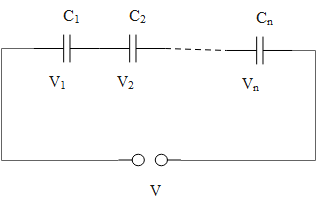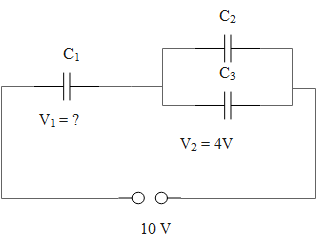Answer
345k+ views
Hint: A capacitor is an electric component used to store charge and energy. The equivalent capacitance of the series combination of the capacitors is the reciprocal of the sum of series of the individual reciprocal values of the capacitance of capacitors. Using the property of the series and parallel combination of capacitors, we will find the capacitance value.
Formula used:
\[C=\dfrac{Q}{V}\]
Complete answer:
An electric component that has the ability to store the electrical energy in form of the charges producing the potential difference is called the capacitor. The capacitance of the capacitor is given as a charge stored by it by the potential difference it produces. The mathematical representation of the same is given as follows.
\[C=\dfrac{Q}{V}\]
The circuit diagram representing the series combination of capacitors is given as follows.

The capacitors are said to be connected in series when the negative plate of one capacitor is connected to the positive plate of the other capacitor and so on. In the case of the series combination of capacitors, the charge across each capacitor remains the same, while the capacitors will have different potential differences across them. So, we have,
\[{{V}_{1}}=\dfrac{Q}{{{C}_{1}}},{{V}_{2}}=\dfrac{Q}{{{C}_{2}}},{{V}_{3}}=\dfrac{Q}{{{C}_{3}}},....,{{V}_{n}}=\dfrac{Q}{{{C}_{n}}}\]
The sum of the potential difference of the individual capacitors equals the equivalent potential difference of the series combination of the capacitors.
\[\begin{align}
& V={{V}_{1}}+{{V}_{2}}+.....+{{V}_{n}} \\
& \Rightarrow \dfrac{Q}{C}=\dfrac{Q}{{{C}_{1}}}+\dfrac{Q}{{{C}_{2}}}+.......+\dfrac{Q}{{{C}_{n}}} \\
\end{align}\]
As the charge across the capacitors remains the same, so, take it in common.
\[\begin{align}
& \dfrac{Q}{C}=Q\left[ \dfrac{1}{{{C}_{1}}}+\dfrac{1}{{{C}_{2}}}+.......+\dfrac{1}{{{C}_{n}}} \right] \\
& \therefore \dfrac{1}{C}=\dfrac{1}{{{C}_{1}}}+\dfrac{1}{{{C}_{2}}}+.......+\dfrac{1}{{{C}_{n}}} \\
\end{align}\]
A relation for equivalent capacitance in the series combination of capacitors is,
\[\dfrac{1}{C}=\dfrac{1}{{{C}_{1}}}+\dfrac{1}{{{C}_{2}}}+.......+\dfrac{1}{{{C}_{n}}}\]
Consider the circuit diagram.

The sum of the potential difference of the individual capacitors equals the equivalent potential difference of the series combination of the capacitors.
\[\begin{align}
& V={{V}_{1}}+{{V}_{2}} \\
& \Rightarrow 10={{V}_{1}}+4 \\
& \therefore {{V}_{1}}=10-4=6\,V \\
\end{align}\]
Therefore, the value of \[{{V}_{1}}\]is 6 V.
\[\therefore \] A capacitor is an electric component used to store charge and energy. A relation for equivalent capacitance in the series combination of capacitors is, \[\dfrac{1}{C}=\dfrac{1}{{{C}_{1}}}+\dfrac{1}{{{C}_{2}}}+.......+\dfrac{1}{{{C}_{n}}}\]. The value of \[{{V}_{1}}\] is 6 V.
Note:
The equivalent capacitance of the series combination of capacitors is computed in the same way as the equivalent resistance of the parallel combination of resistors. Similarly, the equivalent capacitance of the parallel combination of capacitors is computed in the same way as the equivalent resistance of the series combination of resistors.
Formula used:
\[C=\dfrac{Q}{V}\]
Complete answer:
An electric component that has the ability to store the electrical energy in form of the charges producing the potential difference is called the capacitor. The capacitance of the capacitor is given as a charge stored by it by the potential difference it produces. The mathematical representation of the same is given as follows.
\[C=\dfrac{Q}{V}\]
The circuit diagram representing the series combination of capacitors is given as follows.

The capacitors are said to be connected in series when the negative plate of one capacitor is connected to the positive plate of the other capacitor and so on. In the case of the series combination of capacitors, the charge across each capacitor remains the same, while the capacitors will have different potential differences across them. So, we have,
\[{{V}_{1}}=\dfrac{Q}{{{C}_{1}}},{{V}_{2}}=\dfrac{Q}{{{C}_{2}}},{{V}_{3}}=\dfrac{Q}{{{C}_{3}}},....,{{V}_{n}}=\dfrac{Q}{{{C}_{n}}}\]
The sum of the potential difference of the individual capacitors equals the equivalent potential difference of the series combination of the capacitors.
\[\begin{align}
& V={{V}_{1}}+{{V}_{2}}+.....+{{V}_{n}} \\
& \Rightarrow \dfrac{Q}{C}=\dfrac{Q}{{{C}_{1}}}+\dfrac{Q}{{{C}_{2}}}+.......+\dfrac{Q}{{{C}_{n}}} \\
\end{align}\]
As the charge across the capacitors remains the same, so, take it in common.
\[\begin{align}
& \dfrac{Q}{C}=Q\left[ \dfrac{1}{{{C}_{1}}}+\dfrac{1}{{{C}_{2}}}+.......+\dfrac{1}{{{C}_{n}}} \right] \\
& \therefore \dfrac{1}{C}=\dfrac{1}{{{C}_{1}}}+\dfrac{1}{{{C}_{2}}}+.......+\dfrac{1}{{{C}_{n}}} \\
\end{align}\]
A relation for equivalent capacitance in the series combination of capacitors is,
\[\dfrac{1}{C}=\dfrac{1}{{{C}_{1}}}+\dfrac{1}{{{C}_{2}}}+.......+\dfrac{1}{{{C}_{n}}}\]
Consider the circuit diagram.

The sum of the potential difference of the individual capacitors equals the equivalent potential difference of the series combination of the capacitors.
\[\begin{align}
& V={{V}_{1}}+{{V}_{2}} \\
& \Rightarrow 10={{V}_{1}}+4 \\
& \therefore {{V}_{1}}=10-4=6\,V \\
\end{align}\]
Therefore, the value of \[{{V}_{1}}\]is 6 V.
\[\therefore \] A capacitor is an electric component used to store charge and energy. A relation for equivalent capacitance in the series combination of capacitors is, \[\dfrac{1}{C}=\dfrac{1}{{{C}_{1}}}+\dfrac{1}{{{C}_{2}}}+.......+\dfrac{1}{{{C}_{n}}}\]. The value of \[{{V}_{1}}\] is 6 V.
Note:
The equivalent capacitance of the series combination of capacitors is computed in the same way as the equivalent resistance of the parallel combination of resistors. Similarly, the equivalent capacitance of the parallel combination of capacitors is computed in the same way as the equivalent resistance of the series combination of resistors.
Recently Updated Pages
Basicity of sulphurous acid and sulphuric acid are

Assertion The resistivity of a semiconductor increases class 13 physics CBSE

Three beakers labelled as A B and C each containing 25 mL of water were taken A small amount of NaOH anhydrous CuSO4 and NaCl were added to the beakers A B and C respectively It was observed that there was an increase in the temperature of the solutions contained in beakers A and B whereas in case of beaker C the temperature of the solution falls Which one of the following statements isarecorrect i In beakers A and B exothermic process has occurred ii In beakers A and B endothermic process has occurred iii In beaker C exothermic process has occurred iv In beaker C endothermic process has occurred

The branch of science which deals with nature and natural class 10 physics CBSE

What is the stopping potential when the metal with class 12 physics JEE_Main

The momentum of a photon is 2 times 10 16gm cmsec Its class 12 physics JEE_Main

Trending doubts
Difference between Prokaryotic cell and Eukaryotic class 11 biology CBSE

Fill the blanks with the suitable prepositions 1 The class 9 english CBSE

Fill the blanks with proper collective nouns 1 A of class 10 english CBSE

Change the following sentences into negative and interrogative class 10 english CBSE

Difference Between Plant Cell and Animal Cell

What is pollution? How many types of pollution? Define it

Give 10 examples for herbs , shrubs , climbers , creepers

What organs are located on the left side of your body class 11 biology CBSE

How do you solve x2 11x + 28 0 using the quadratic class 10 maths CBSE




